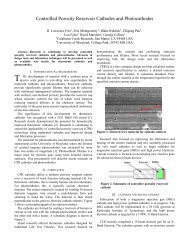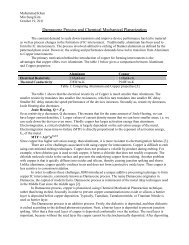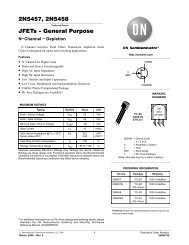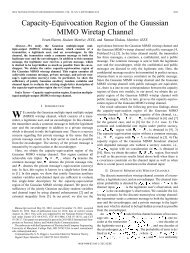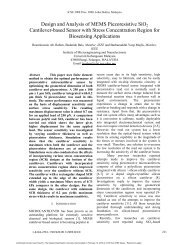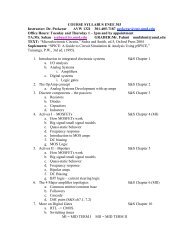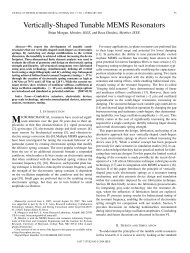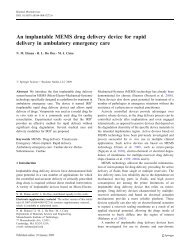A BioMEMS Review: MEMS Technology for Physiologically - ECE ...
A BioMEMS Review: MEMS Technology for Physiologically - ECE ...
A BioMEMS Review: MEMS Technology for Physiologically - ECE ...
Create successful ePaper yourself
Turn your PDF publications into a flip-book with our unique Google optimized e-Paper software.
followed by cells frequently leads to device fouling and<br />
failure. Major research ef<strong>for</strong>ts are dedicated toward developing<br />
methods to substantially reduce the phenomenon and<br />
produce devices that do not promote biofouling, yet retain<br />
their biocompatibility. This ef<strong>for</strong>t often takes the <strong>for</strong>m of<br />
surface chemical modification of silicon, silicon oxide, or<br />
metal surfaces on the device. Little of this work, however,<br />
has been conducted on functional drug delivery <strong>MEMS</strong><br />
devices. There<strong>for</strong>e, the results described here use modification<br />
methods on materials that are often incorporated<br />
into <strong>MEMS</strong> devices. Several recent reviews cover general<br />
issues in bioadhesion and protein adsorption without specifically<br />
addressing <strong>MEMS</strong> devices [119], [120]. Chemical<br />
modification to reduce biofouling falls into one of two<br />
general methods. The first method uses surface immobilized<br />
polymers that reduce adsorption of biological materials. The<br />
second method relies on the self-assembly [121] process<br />
to passivate the <strong>MEMS</strong> device surface. Specific examples,<br />
methods of preparation and characterization, and representative<br />
results <strong>for</strong> these two methods are described below.<br />
1) Surface Immobilized Polymers: Many of the<br />
polymer-based modification methods rely on attachment<br />
of poly (ethylene glycol) (PEG) or its analogues to the<br />
surface [122]–[124]. The ability of these materials to inhibit<br />
protein adsorption and there<strong>for</strong>e reduce biofouling has been<br />
known <strong>for</strong> decades [125]. Other related polymers are also<br />
being explored to minimize protein adsorption. Recent<br />
examples include tetraglyme (CH O(CH CH O) )CH )<br />
[126] and copolymers of ethylene glycol such as poly<br />
(acrylamide-co-ethylene glycol) [127] and poly (L-lysine)<br />
grafted with PEG side chains [128]. The development of<br />
copolymers containing ethylene glycol may enable more<br />
precise tailoring of materials surface properties.<br />
Numerous methods <strong>for</strong> the immobilization of the polymer<br />
onto silicon, silicon oxide, metal, or metal oxide surfaces<br />
have been developed. Grafting by way of photoinduced<br />
polymerization or chemical surface attachment to silicon<br />
oxide are two common preparative methods [122], [124],<br />
[127]. Vapor deposition techniques [122] and gas-phase<br />
plasma polymerization [123] also yield polymer-coated<br />
surfaces. The grafting of PEG onto cationic polymer chains<br />
such as poly (L-lysine) enables attachment to negatively<br />
charged surfaces (silica and some metal oxides) via simple<br />
electrostatic interactions [128]. Films are characterized<br />
through a variety of surface analytical methods such as contact<br />
angle goniometry, X-ray photoelectron spectroscopy,<br />
ellipsometry, surface plasmon resonance spectroscopy,<br />
probe microscopy, and secondary ion mass spectrometry.<br />
The polymer film <strong>for</strong>mation dictates many physicochemical<br />
properties of the interface. In general, however, the polymer<br />
film thickness falls in the 2- to 20-nm range. Additionally,<br />
the modified surfaces are usually hydrophilic regardless of<br />
the nature of the underlying substrate.<br />
The utility of the polymer-modified surface against biofouling<br />
is probed by incubation in a biological medium. The<br />
medium contains either a protein (e.g., albumin, fibrinogen,<br />
or Immunoglobulin G) or a cell line (fibroblast, HeLa, or<br />
endothelial). Following incubation, researchers measure the<br />
amount of adherent materials and compare to unmodified<br />
controls. In all studies, substantial reduction of adherent<br />
protein/cells is seen. A study of PEG on silicon surfaces<br />
[122] is of particular interest to those in the <strong>MEMS</strong> field.<br />
The researchers fabricated nanostructured thin ( 2.0 nm)<br />
films of PEG on silicon substrates. The nanostructured<br />
nature of the film may enable retention of <strong>MEMS</strong> device<br />
functionality by minimizing the inhibition of molecular<br />
transport to or from the device. The system reduces by<br />
approximately a factor of ten the amount of bovine serum<br />
albumin that adheres to unmodified silicon in devices.<br />
Hanein et al. [123] fabricate micromachined PEG films<br />
using standard photolithographic techniques. The technique<br />
shows promise due to its application to myriad surfaces,<br />
including silicon, silicon oxide, silicon nitride, gold, and<br />
platinum. Importantly <strong>for</strong> some <strong>MEMS</strong> applications, the<br />
conductivity of the metal substrate is retained.<br />
2) Self-Assembled Monolayers: Certain types of self-assembled<br />
monolayers (SAM) have been known <strong>for</strong> more than<br />
a decade to passivate surfaces against protein and cellular<br />
adsorption [129]. These monolayers spontaneously <strong>for</strong>m<br />
dense overlayers on numerous surfaces relevant to <strong>MEMS</strong>.<br />
The first type of SAM shown to reduce biofouling is an oligo<br />
(ethylene glycol) terminated alkanethiol moiety. A number<br />
of other SAMs resistant to adsorption have been identified<br />
since the initial studies in which two to six ethylene glycol<br />
groups sufficiently reduced protein and cellular adsorption.<br />
A wide range of terminally functionalized alkanethiols<br />
has been found to be protein resistant [130]. Useful functional<br />
groups include some amides, amines, ethers, nitriles,<br />
and sugars. The breadth of chemical groups allows some<br />
tailoring of surface properties. Other SAMs of note <strong>for</strong><br />
<strong>MEMS</strong> devices are alkoxysilyl [124] and trichlorosilyl<br />
terminated PEG [131], and PEG terminated trialkoxysilanes<br />
[132] and trichlorosilanes [120]. These species react<br />
with oxide surfaces, particularly silicon oxide, to yield<br />
robust protein-resistant interfaces. A final system related<br />
to the SAM-modified surfaces bears note. Researchers<br />
have suppressed the protein adsorption on silicon surfaces<br />
by transferring phospholipid-based Langmuir–Blodgett<br />
monolayers to device surfaces [133].<br />
The <strong>for</strong>mation method <strong>for</strong> both the thiol on metal and<br />
silane on oxide systems is very simple. The thiols <strong>for</strong>m a<br />
strong sulfide–metal bond spontaneously from ethanolic solutions.<br />
The trichlorosilane and trialkoxysilane systems also<br />
produce a strong interfacial bond, in this case a Si–O–Si<br />
bridge, between substrate and adsorbate. The latter reaction<br />
is catalyzed in solution using an amine. Although immersion<br />
of the <strong>MEMS</strong> device into a solution containing the target<br />
molecule produces useful layers, methods <strong>for</strong> patterning of<br />
the layers allow <strong>for</strong> more flexibility. The SAM is generally<br />
patterned either with standard photolithographic techniques<br />
or with stamping of monolayer molecules using a patterned<br />
mold [119], although some patterning of SAMs had been<br />
achieved by using computer-controlled laser ablation [134].<br />
Patterning the SAM allows the electrochemical properties of<br />
the device to be retained in specific regions. This is particularly<br />
vital <strong>for</strong> <strong>MEMS</strong> devices relying on electrochemical<br />
GRAYSON et al.: A BIO<strong>MEMS</strong> REVIEW: <strong>MEMS</strong> TECHNOLOGY FOR PHYSIOLOGICALLY INTEGRATED DEVICES 13<br />
Authorized licensed use limited to: University of Maryland College Park. Downloaded on February 8, 2009 at 16:17 from IEEE Xplore. Restrictions apply.



